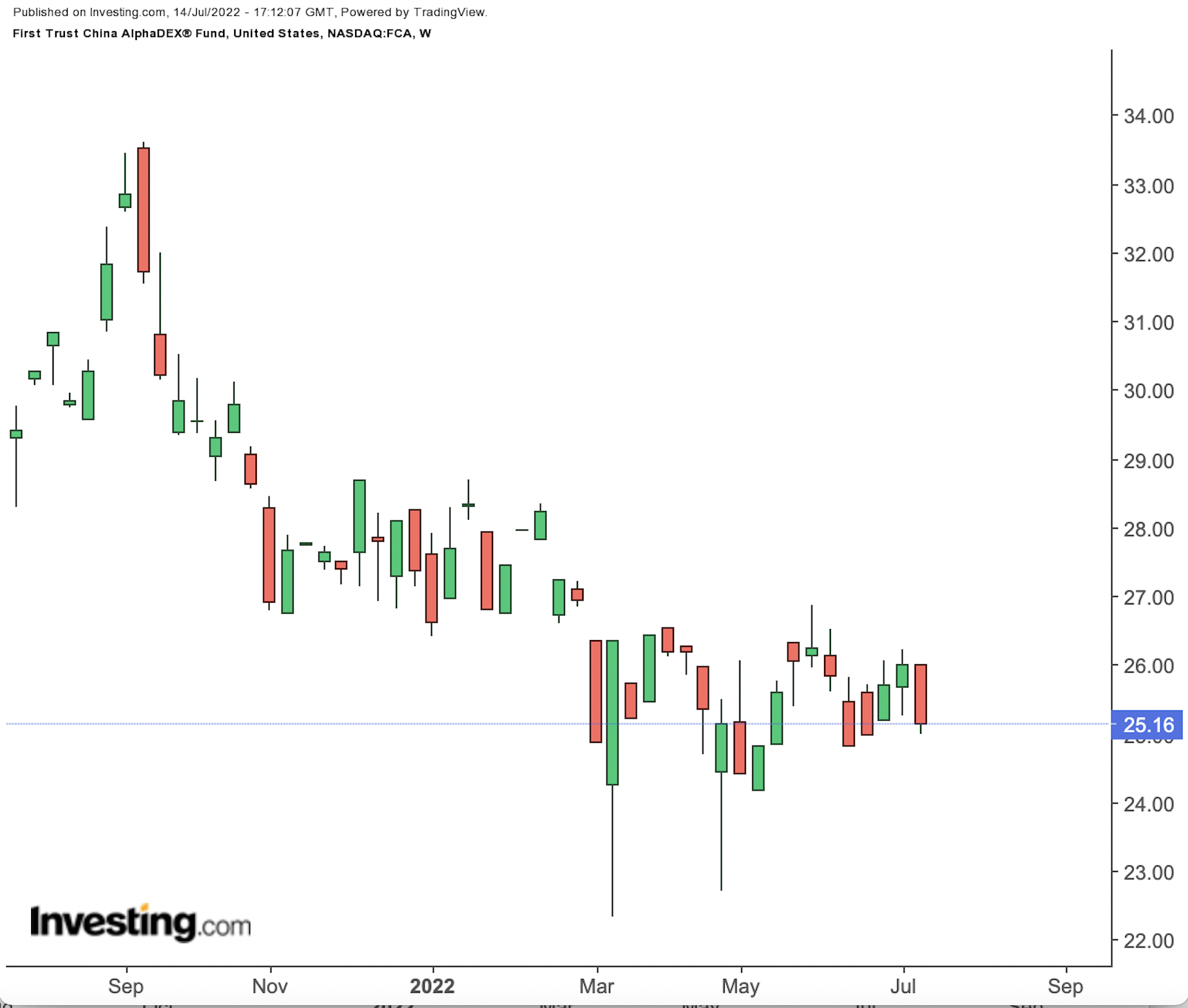- Easing of COVID lockdowns and relaxation of regulatory pressure on tech firms in China behind investor interest in Chinese equities
- Potential lowering of U.S. tariffs on Chinese goods
- China ETFs for investors looking for international diversification
In June, investors poured a record amount into the exchange-traded funds (ETFs) tracking Chinese equities. The flood of cash came as China’s strict COVID lockdowns were eased, and regulators signaled a less severe approach to policing the country’s tech sector almost a year after an unprecedented crackdown. Meanwhile, the Biden administration is debating whether to lower the tariffs on Chinese goods—which could be another near-term catalyst for the market.
As a result, the Shenzhen Composite Index, one of the two benchmark indices in mainland China, has returned 4.1% over the past month, while the Shanghai Composite Index remained about flat. However, so far in the year, these indices have lost around 13.5% and 9.8%, respectively. By comparison, the S&P 500 and the Dow Jones Industrial Average fell 21.5% and 16.9%, respectively, over the same period.
Nonetheless, some investors are still questioning where Chinese equities may go from here, especially given the uncertainty of the macro environment.
“Future demand depends on the likelihood of further lockdowns as the government remains committed to its zero-COVID policy,” said Iris Pang, chief economist for Greater China at ING.
Thus, the question remains whether relaxations of pandemic regulations and the easing of internet regulation, alongside government stimulus, could continue to buoy the Chinese stock market. That said, here are two China ETFs that could appeal to readers looking to add international diversification to their portfolios.
1. Global X MSCI China Consumer Discretionary ETF
Current Price: $21.87
52-Week Range: $15.19 - $34.03
Dividend Yield: 0.27%
Expense Ratio: 0.65% per year
China is the world's second-largest economy after the U.S. It is also the world’s most populous nation with a vastly expanding urban middle class.
The Global X MSCI China Consumer Disc ETF (NYSE:CHIQ) targets an increasingly popular investment theme within China—the consumer. The fund mainly invests in equities of Chinese large- and mid-cap consumer discretionary companies.

Source: Investing.com
CHIQ, which started trading in November 2009, tracks the MSCI China Consumer Discretionary 10/50 Index. It has 72 holdings. Sub-sector exposure includes internet retail (24.5%), motor vehicles (23.4%), apparel/footwear (9.9%), internet software/devices (8.6%) and other consumer services (7.4%).
The ETF’s top 10 stocks make up half of the fund, which net assets stand at $375.3 million. Among the leading names are e-commerce giants Alibaba (NYSE:BABA) and JD.Com (NASDAQ:JD), and food delivery platform Meituan (OTC:MPNGY). Next are car manufacturers BYD (OTC:BYDDY)) and Nio (NYSE:NIO).
CHIQ has declined more than 14% since January. It hit a 52-week low on March 15. Its trailing P/E and P/B ratios stand at 28.74x and 1.76x. Readers whose portfolios can handle short-term choppiness could consider buying CHIQ to benefit from the long-term growth in the Chinese consumer discretionary segment.
2. First Trust China AlphaDEX Fund
Current Price: $25.16
52-Week Range: $22.32 - $33.62
Dividend Yield: 5.44%
Expense Ratio: 0.80% per year
The First Trust China AlphaDEX® Fund (NASDAQ:FCA) offers exposure to Chinese equities through a concentrated portfolio of 50 stocks selected from the NASDAQ China Index based on a number of growth and value factors. The fund started trading in April 2011.

Source: Investing.com
The largest 10 holdings account for roughly one-third of the small fund’s $8.9 million in net assets. With regards to sectoral breakdown, we see utilities (16%), materials (15.2%), industrials (14%), energy (13.9%) and information technology (10.1%).
Leading names include the real estate developer China Overseas Land Investment (OTC:CAOVY); China Hongqiao Group (HK:1378), which manufactures aluminum products; integrated energy group China Power International Development (HK:2380); China State Construction International Holdings (HK:3311); and automobile manufacturer Dongfeng Motor Group Co (OTC:DNFGF).
FCA saw a multi-year high in September 2021. Yet, it is down more than 8.8% so far this year and 20.5% over the past 12 months. The fund’s trailing price-to-earnings (P/E) and price-to-book (P/B) ratios are 6.20x and 0.78x, respectively. Investors who expect the recovery in Chinese stocks to continue can consider researching FCA further.
Disclosure: Tezcan Gecgil, Ph.D., does not have any positions in the securities mentioned in this article.
